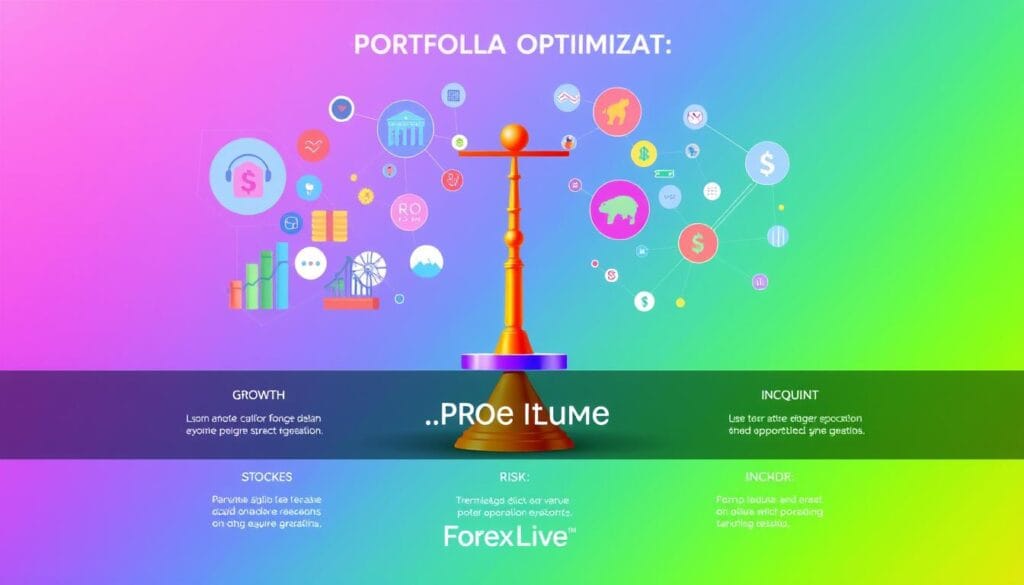בעולם המהיר של הפיננסים, יש לך צורך ב אסטרטגיות מסחר הנכונות. מדריך זה יראה לך שיטות מסחר אפקטיביות שונות. אלו יכולות לעזור לך לנוע בשווקים בביטחון ובדיוק. זה לא משנה אם אתה מנוסה או חדש בהשקעות. תמצא אסטרטגיות שיכולות לשפר את כישורי המסחר שלך ולהגדיל את הרווחים שלך.
אנו נכסה את היסודות של ניתוח טכני וניתוח יסודי. תלמד גם על ניהול סיכון וכיצד לייעל את התיק שלך. זה יעזור לך לזהות טרנדים שוק, להבין נתונים, ולקבל החלטות חכמות שמתאימות למטרות ההשקעה שלך. נחקור גם מסחר אלגוריתמי ו- בדיקה לאחור. כלים אלה יכולים לעזור לך להעביר את המסחר שלך לרמה הבאה.
מדריך זה מדגיש את הצורך להבין דינמיקה שוק ולסחור ביעילות. גישה מורכבת לתיק השקעות שלך היא גם מפתח להפחתת סיכון. על ידי למידת כישורים חשובים אלה, אתה בדרכך להגברת הרווחים שלך ולהשגת מטרות הפיננסיות שלך.
מסקנות עיקריות
- גלה מגוון שיטות מסחר אפקטיביות לשיפור הרווחיות שלך
- הבנה של יסודות ניתוח טכני וניתוח יסודי לקבלת החלטות מושכלות
- גילוי חשיבותה של ניהול סיכון ואופטימיזצית תיק השקעות במסחר מוצלח
- צלילה לעולם המסחר אלגוריתמי ובדיקה אחורית כדי להעלות את המסחר שלך לרמה הבאה
- קבלת תובנות בטבע הדינמי של שווקים פיננסיים ואיך לנווט בהם ביעילות
הבנת דינמיקה של שווקים
בעולם המסחר, הצלחה תלויה בידע על אופן פעולתם של השווקים הפיננסיים. למידת ניתוח טכני ו-ניתוח יסודי עוזרת לך להבין מה מניע את טרנדים שוק ופסיכולוגיה.
טכניקות ניתוח טכני
ניתוח טכני מביט בתנועות מחיריות ותבניות בשוק כדי לזהות הזדמנויות מסחר. הטכניקות העיקריות כוללות:
- זיהוי דפוסי תרשים, כגון ראש וכתפיים, קיפול כפול, וייצור דגלים
- ניתוח מגמה, באמצעות כלים כמו ממוצעים נעים וקווים מגמה כדי לזהות את כיוון ועוצמת השוק
- אינדיקטורי מומנטום, כמו מדד הכוח היחסי (RSI) ואוסילטור סטוכסטי, כדי למדוד את קצב שינויי המחיר
עקרונות ניתוח יסודי
ניתוח יסודי מביט בגורמים כלכליים ופיננסיים שמשפיעים על מגמות ופסיכולוגיה של השוק. זה מבקש מדדים כלכליים, מגמות תעשייתיות, ומידע פיננסי שיעזור לראות את הערך האמיתי של נכס. זה עוזר לסוחרים לקבל החלטות חכמות ולנבא תנועות שוק.
בשילוב של ניתוח טכני וניתוח יסודי, סוחרים מקבלים תמונה מלאה של השוק. הגישה הזו עוזרת לך להבין טוב יותר את העולם הפיננסי ולבצע עסקאות רווחיות.
"המפתח למסחר מוצלח הוא הבנת הגורמים הבסיסיים שמניעים את ההתנהגות של השוק, ולא רק תנועות המחיר בשכבת הפנים."
יסודות ניהול סיכונים
ניהול סיכונים אפקטיבי הוא מרכזי לאסטרטגית מסחר מוצלחת. כסוחר, חשוב להבין וליישם עקרונות ניהול סיכונים חשובים. העקרונות הללו עוזרים להגן על ההון שלך ולנהל את התנודות בשוק.
גודל עמדה הוא חלק מרכזי של ניהול סיכונים. זה אומר להחליט כמה גדול צריך להיות המסחר שלך בהתבסס על סוגת הסיכון שלך ועל גודל החשבון שלך. גישה זו עוזרת למנוע חשיפה יתר עבור הכספים שלך. זה גם מגביל את השפעת ההפסדים האפשרית, משמר את המסחר שלך בצורה קיימת.
הזמנים לעצירת הפסדים חיוניים לניהול סיכונים. הזמנים הללו סוגרים מסחר כאשר השוק מגיע למחיר מוגדר, מגבילים את ההפסדים שלך. הוספת הזמנים לעצירת הפסדים לאסטרטגיה שלך מציעה רשת ביטחון ועוזרת לנהל סיכון בצורה יעילה.
הדיברסיפיקציה גם היא מרכזית לניהול סיכונים. לפזר את ההון שלך בין מחלקות נכסים שונות ושווקים יכולה להפחית את הסיכון הכולל שלך. זה עוזר להפחית את ההשפעה של ההפסדים בהשקעה אחת, ומבטיח כי המסחר שלך יהיה עמיד יותר.
שליטה בניהול סיכונים היא חיונית עבור סוחרים. על ידי שימוש בעקרונות אלה, תוכל להגן על ההון שלך, לשלוט בחשיפה שלך, ולשפר את הסיכויים שלך להצלחה לטווח הארוך.
| עקרון ניהול סיכונים | תיאור | יתרונות מרכזיים |
|---|---|---|
| גודל עמדה | קביעת גודל העסקה המתאים בהתאם לסוג הסיכון וגודל החשבון | מקטין את ההשפעה של ההפסדים האפשריים, מבטיח את הקיומות של פעילויות המסחר |
| הפסקת אבדן | סגירה אוטומטית של עמדה כאשר השוק מגיע לרמת מחיר שקובענו מראש | מגביל את הסיכון למטה, מונע הפסדים חשובים |
| הרכבה מורכבת | הפצת הון בין מספר רב של מחלקות נכסים, כלים למסחר ותחומי שוק | מפחית את הסיכון הכולל של תיק ההשקעות, משפר את הגמישות של הגישה למסחר |
"ניהול סיכונים הוא לא רק על הגנה על ההון שלך, אלא גם על שמירה על יכולתך לסחור גם ביום אחר."
הרבים ואופטימיזציה של תיק השקעות
ניהול התיק שלך בצורה יעילה הוא המפתח לקבלת החזרים המתואמים לסיכון. בלב הדבר נמצאת הרבים, שמשמעו פיזור הכסף שלך בין סוגי השקעות שונים. זה עוזר לך להתמודד עם התנודות בשוק ולהוריד את הסיכון שלך.
אסטרטגיות הקצאת נכסים
הקצאת נכסים משמעה למצוא את השילוב הטוב ביותר של נכסים עבור התיק שלך. אפשר להשתמש בשיטות פשוטות כמו חלוקה של 60/40 בין מניות לאגרות חוב. או שניתן לנסות אסטרטגיות מורכבות יותר שכוללות נדל"ן, סחורות, והון פרטי.
כאשר אתה מגדיר את הקצאת הנכסים שלך, חשוב לחשוב על מה שאתה רוצה להשיג, כמה סיכון אתה יכול לקחת, ומתי אתה זקוק לכסף. תיק מרובה הרבים יכול לעזור לך להשיג את מטרותיך הפיננסיות בזמן שמנהל את הסיכונים.
| מחלקת נכסים | הקצאה (%) | החזר עם תיקון לסיכון |
|---|---|---|
| מניות | 60% | גבוה |
| אגרות חוב | 30% | שקט |
| נדל"ן | 5% | שקט-גבוה |
| סחורות | 5% | גבוה |
טבלה זו מציגה אסטרטגיית הפצת נכסים מוגבלת. היא מאזנת בין סיכון והחזר כדי להשיג את מטרות ההשקעה שלך.

"ההפצה היא הארוחת צהריים היחידה בהשקעות." – הארי מרקוביץ, זוכה פרס נובל לכלכלה
למידה על אופטימיזצית תיק השקעות והפצת נכסים עוזרת לך ליצור תיק השקעות מאוזן. תיק זה מיועד לטפל בשינויים בשוק ולכוון ל החזרים מתואמי סיכון במהלך הזמן.
אסטרטגיות מסחר
יש לצייד עצמך במספר אסטרטגיות מסחר כדי להצליח בשווקים הפיננסיים המהירים. אלו כוללים עוקבי מגמה, היפוך ממוצע, תנודה, ושבירת מגבלות אסטרטגיות. לכל אחת יתרונותיה ודברים לשקול. הבנתם יכולה לעזור לך לבחור את הטובות ביותר עבור סגנונות המסחר שלך והשוק.
אסטרטגיות עוקבות אחרי מגמה
אסטרטגיות עוקבות אחרי מגמה משתמשות במגמת השוק כדי להרוויח כסף. הן נכנסות כאשר המגמה ברורה ויוצאות כאשר היא משתנה. השיטה יכולה להיות עוצמתית אך דורשת סבלנות ויכולת להתמודד עם התנודות בשוק.
אסטרטגיות השתלשלות לממוצע
אסטרטגיות השתלשלות לממוצע מאמינות שמחירים יחזרו לממוצעם במהלך הזמן. הן מחפשות מתי המחירים גבוהים מדי או נמוכים מדי כדי להמר על חזרה למצב רגיל. זה עשוי לעבוד טוב בשווקים שאינם מתמגמים הרבה אך יכול שלא יעבוד טוב במגמות חזקות.
אסטרטגיות תנועה
אסטרטגיות תנועה מתמקדות בנכסים שמוצלחים לאחרונה. הן יוצאות לדרך להמשיך להרוויח כסף מהנכסים הללו. זה עשוי לעבוד טוב בשווקים המתמגמים אך יכול להיות סוחף אם המגמה מסתיימת באופן פתאומי.
אסטרטגיות פריצה
אסטרטגיות פריצה מחפשות תנודות מחיר גדולות מעבר לרמות מסוימות. הן חושבות שתנודות אלו לעתים קרובות מתחילות מגמות חדשות. האסטרטגיה הזו עשויה לעבוד טוב בשווקים שמתנודדים הרבה אך דורשת הבנה טובה של דפוסי השוק.
חקירת האסטרטגיות הללו עוזרת למשקיעים לפתח דרך חזקה להתמודד עם השווקים. לכל אסטרטגיה יש יתרונות וחסרונות משלה. הבחירה הטובה ביותר תלויה ברמת הסיכון שלך, בשוק ובדרך שבה אתה אוהב לסחור.
| אסטרטגיית מסחר | תיאור | יתרונות אפשריים | חסרונות אפשריים |
|---|---|---|---|
| עוקב אחר מגמה | מניה על תנודות מחירים מתמדות בכיוון מסוים |
|
|
| השתלשלות לממוצע | זיהוי וניצול של נכסים שמשתלשלים לממוצעים ההיסטוריים שלהם |
|
|
| תנודה | מניה על מגמת נכסים עם ביצועים חזקים בזמן האחרון להמשיך להיות מובילים |
|
|
| שיא | זיהוי וניצול של תנודות מחיר משמעותיות ששוברות דרך ברמות תמיכה או התנגדות מרכזיות |
|
|
להבין את אסטרטגיות המסחר הללו עוזר למשקיעים ליצור תוכנית גמישה ויעילה עבור שווקי המוצרים.

ביצוע וניהול הזמנות
ביצוע הזמנות יעיל וניהול עסקאות הם מרכיבים מרכזיים להצלחת המסחר. נבחן סוגי הזמנות כמו שוק והגבלת הזמנות. נכסוף גם כיצד להיכנס ולצאת מעסקאות כדי לשפר את תוצאות המסחר שלך.
סוגי הזמנות וביצוע עסקאות
לסוחרים יש הרבה אפשרויות לביצוע הזמנות. הזמנות שוק קונות או מוכרות במחיר הטוב ביותר הזמין. הגבלת הזמנות מאפשרות לסוחרים לקבוע את המחיר שלהם. לדעת את ההבדלים בין הזמנות אלו חיוני לניהול הזמנות בצורה יעילה.
אסטרטגיות כניסה ויציאה מעסקאות
קיום תוכנית יציבה לכניסה ויציאה מעסקאות הוא קריטי. תנאי השוק,
ניתוח טכני, וניהול סיכונים עוזרים להחליט על הזמנים הטובים ביותר לסחור. על ידי חשיבה על הגורמים הללו, סוחרים יכולים לבצע עסקאות במחירים טובים ולצמצם את ההפסדים.
| סוג הזמנה | תיאור | יתרונות | חסרונות |
|---|---|---|---|
| הזמנת שוק | הזמנה לקנות או למכור נייר ערך במחיר הזמין הטוב ביותר | ביצוע מיידי, אין אי-וודאות במחיר | סיכוי להחלקה, פחות שליטה על המחיר |
| הזמנת מגבלה | הזמנה לקנות או למכור נייר ערך במחיר מסוים או יותר טוב | שליטה יותר על המחיר, אין סיכון להחלקה | סיכוי לא ביצוע, ביצוע פחות מיידי |

"שליטה ב-ביצוע הזמנה וניהול סחר היא היסוד של מסחר רווחי. הבנת הפינות המעניינות של סוגי הזמנות שונים ואיך לתזמן את הכניסות והיציאות שלך עשויים לעשות את כל ההבדל בהצלחת המסחר שלך."
על ידי למידה על סוגי הזמנות ואסטרטגיות לכניסה ויציאה מעסקאות, סוחרים יכולים לשפר באופן משמעותי את ביצועי המסחר והרווחים שלהם.
מסחר אלגוריתמי ובדיקה לאחור
בשווקים הפיננסיים המהירים של היום, מסחר אלגוריתמי ו-בדיקה לאחור הם מרכיבים מרכזיים לסוחרים המעוניינים לשפר. כלי אלה משתמשים באלגוריתמים מתקדמים ומערכות כדי לבצע עסקאות במהירות ובדיוק. זה עשוי לתת לסוחרים יתרון על אחרים.
מסחר אלגוריתמי, ידוע גם כ-
מסחר אוטומטי, משתמש בתוכניות מחשב כדי לבדוק נתוני שוק ולבצע עסקאות באופן עצמאי. שיטה זו עוזרת לסוחרים להימנע מקבלת החלטות מבוססות על רגשות או דעות קדומות. זה מאפשר גם לאלגוריתמים לעבד מהר כמויות רבות של נתונים ולבצע עסקאות מהירות, תופסת תנועות שוק שעשויות להיות קשות לראות על ידי אנשים.
בדיקה אחורית היא על בדיקת אסטרטגיית מסחר או אלגוריתם עם נתוני שוק מהעבר. זה מאפשר לסוחרים לראות כמה טוב עשרטגיה עשויה להתקיים, למצוא דרכים לשפר ולכוון את אסטרטגיות המסחר שלהם לפני שישתמשו בכסף אמיתי.
ביחד, מסחר אלגוריתמי ובדיקה אחורית מביאים רמות חדשות של יעילות ודיוק למסחר. על ידי אוטומציה של עסקאות ובדיקת אסטרטגיות, סוחרים יכולים להוריד את הסיכון לטעויות, להיות יותר עקביים, ואולי להרוויח יותר כסף במהלך הזמן.
היתרונות העיקריים של מסחר אלגוריתמי ובדיקה אחורית
- מהירות בביצוע ודיוק משופרים
- הפחתת השפעות רגשיות וסובייקטיביות בקבלת החלטות
- יכולת לעבד ולנתח כמויות גדולות של נתוני שוק
- ניהול סיכונים משופר דרך גודל פוזיציה אוטומטי והזמנות עצירת הפסד
- אופטימיזציה של אסטרטגיות מסחר דרך בדיקה אחורית וסימולציה מקיפה
| תכונה | סחר אלגוריתמי | בדיקה לאחור |
|---|---|---|
| מהירות ביצוע | מהירות יתרה, עם היכולת להגיב לשינויים בשוק במילישניות | מדמה תנאי שוק היסטוריים כדי להעריך ביצועי אסטרטגיה |
| ניהול רגשות | מסיר רגשות ופולשנות אנושית מתהליך הסחר | מאפשר לבצע הערכה עצמית של אסטרטגיות סחר ללא התערבות רגשית |
| עיבוד נתונים | יכול לנתח ולעבד כמויות עצומות של נתוני שוק בזמן אמת | משתמש בנתוני שוק היסטוריים כדי לבחון בצורה מעמיקה את אסטרטגיות הסחר |
| ניהול סיכון | מאפשר גודל תיק אוטומטי והזמנות עצירת הפסד לשיפור בקרת סיכון | עוזר לזהות ולשקף פרמטרים אופטימליים לניהול סיכון עבור אסטרטגיות סחר |
| אופטימיזצית אסטרטגיה | מאפשר את היישום והביצוע של אסטרטגיות סחר מורכבות | מקל על אופטימיזציה של אסטרטגיות סחר דרך בדיקה ושיפור רב-פעמי |
חקירת מסחר אלגוריתמי ובדיקה אחורית עשויים לפתוח דרכים חדשות לסוחרים לשפר את ביצועיהם. זה עוזר להם להשיג הצלחה יציבה ומבוססת נתונים בשווקים הפיננסיים.
מסקנה
מדריך זה הראה לך כיצד לסחור בביטחון ולהרוויח יותר כסף. על ידי למידה על מגמות שוק, ניהול סיכונים, פיזור השקעות, ושיפור דרכי המסחר שלך, תוכל להצליח יותר בטווח הארוך.
תמיד תמשיך ללמוד ולעדכן את שיטות המסחר שלך כדי להיות מוביל. הסוד להצלחה במסחר הוא להתאים את עצמך לשינויים בשוק, להפחית סיכונים, ולהשתלט על ההזדמנויות. על ידי שימוש בטיפים ובאסטרטגיות ממאמר זה, אתה בדרך להשגת המטרות הפיננסיות שלך.
התובנות והאסטרטגיות הללו שימושיות גם לסוחרים חדשים ומנוסים. הן עשויות לעזור לך לשפר את מיומנויות המסחר שלך ולהגדיל את הרווחים שלך. עקוב אחר הטיפים לניתוח השוק, ניהול הסיכונים, ואופטימיזציה של התיק השקעות שלך כדי לשפר את יכולות המסחר שלך.
שאלות נפוצות
מהם העקרונות המרכזיים של ניתוח טכני?
איך ניתוח יסודי יכול לעזור לי להבין את השווקים?
מהם הרכיבים החיוניים של ניהול סיכון יעיל?
איך אני יכול לייעל את תיק המסחר שלי?










